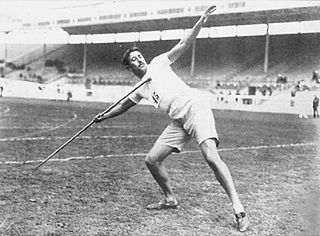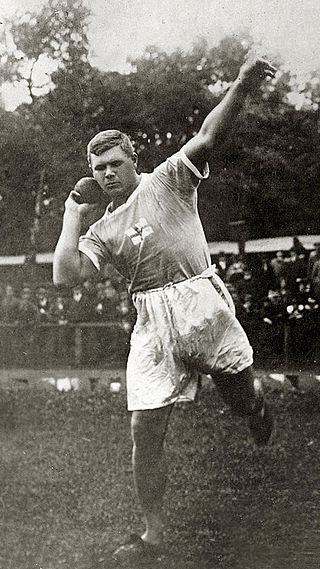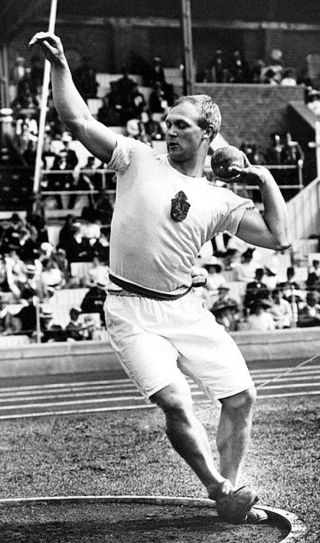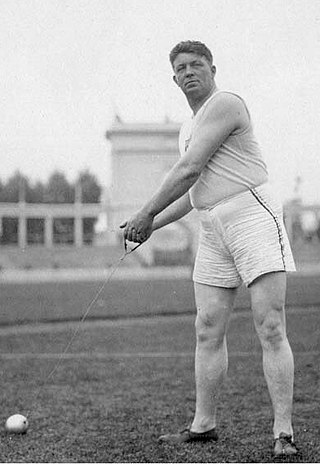
The javelin throw is a track and field event where the javelin, a spear about 2.5 m in length, is thrown as far as possible. The javelin thrower gains momentum by running within a predetermined area. Javelin throwing is an event of both the men's decathlon and the women's heptathlon.

The men's javelin throw was one of six throwing events on the Athletics at the 1908 Summer Olympics programme in London. The javelin was required to be held in the middle. The competition was held on 17 July 1908. 16 throwers from six nations competed. NOCs could enter up to 12 athletes.
The men's freestyle javelin throw was one of six throwing events on the Athletics at the 1908 Summer Olympics programme in London. The javelin could be held anywhere, as opposed to the standard javelin throw which required the javelin to be held by a grip in the middle. This was the only time such a "freestyle" event was held at the Olympics. The competition was held on 15 July 1908. 33 throwers from nine nations competed. NOCs could enter up to 12 athletes.
Urho Pellervo Peltonen was a Finnish athlete who competed mainly in the javelin throw.

Finland competed at the 1920 Summer Olympics in Antwerp, Belgium for the first time as a fully independent state. It did compete at the previous Olympics, however, only as the Russian-dependent Grand Duchy of Finland. 63 competitors, 62 men and 1 woman, took part in 51 events in 9 sports.

The men's javelin throw was a track and field athletics event held as part of the athletics at the 1912 Summer Olympics programme. It was the second appearance of the event. The competition was held on Saturday, July 6, 1912. Twenty-five javelin throwers from seven nations competed. NOCs could enter up to 12 athletes.

Uwe Hohn is a retired German track and field athlete who competed in the javelin throw. He is the only athlete to throw a javelin 100 metres or more, with his world record of 104.80 m. A new javelin design was implemented in 1986 and the records had to be restarted, thus Hohn's mark became an "eternal world record". He coached Indian track and field athlete Neeraj Chopra, who won the gold in the men's javelin throw at the 2020 Summer Olympics held in Tokyo.

The men's shot put event was part of the track and field athletics programme at the 1920 Summer Olympics. The competition was held on Tuesday, August 17, 1920, and on Wednesday, August 18, 1920. Twenty shot putters from ten nations competed. No nation had more than 4 athletes, suggesting the limit had been reduced from the 12 maximum in force in 1908 and 1912. The event was won by Ville Pörhölä of Finland, the first time the men's shot put was won by someone not from the United States. Fellow Finn Elmer Niklander took silver. The Americans, who had won all five previous editions of the shot put, including three medal sweeps, settled for bronze by Harry B. Liversedge.

The men's discus throw event was part of the track and field athletics programme at the 1920 Summer Olympics. The competition was held on Saturday, August 21, 1920, and on Sunday, August 22, 1920. 17 discus throwers from eight nations competed. No nation had more than 4 athletes, suggesting the limit had been reduced from the 12 maximum in force in 1908 and 1912. The event was won by Elmer Niklander of Finland, the nation's second consecutive victory in the men's discus throw. Armas Taipale, the winner in 1912, took silver to become the second man to win multiple medals in the event. Gus Pope took bronze, continuing the American streak of podium appearances at all six discus competitions to date.

The men's hammer throw event was part of the track and field athletics programme at the 1920 Summer Olympics. The competition was held on Wednesday, August 18, 1920. 12 throwers from 5 nations competed; four from Sweden, four from the United States, two from Canada, one from Great Britain, and one from Finland. No nation had more than 4 athletes, suggesting the limit had been reduced from the 12 maximum in force in 1908 and 1912. The event was won by Patrick Ryan of the United States, the nation's fifth consecutive victory in the event. Carl Johan Lind took silver, earning Sweden's first medal in the hammer throw. Another American, Basil Bennett, earned bronze.

Arthur Wood Tuck was an American track and field athlete. In 1919, he singlehandedly won the Oregon state high school track and field team championship for Redmond High School. He later competed for the University of Oregon track and field team and represented the United States in the 1920 Summer Olympics in Belgium.
The men's javelin throw event was part of the track and field athletics programme at the 1928 Summer Olympics. The competition was held on Thursday, August 2, 1928. Twenty-eight javelin throwers from 18 nations competed.
The men's javelin throw event at the 2008 Summer Olympics took place on 21 and 23 August at the Beijing National Stadium. The qualification mark was set at 82.50 metres.

Tonga participated in the 2012 Summer Paralympics in London, United Kingdom, from August 29 to September 9, 2012. Their participation marked their fourth consecutive Summer Paralympics appearance since their début at the 2000 Summer Paralympics in Sydney. Tonga was represented by the Tonga National Paralympic Committee, and was one of the 45 participating countries that sent only a single athlete. Tonga has always sent only a single athlete from Sydney 2000 to London 2012. Tonga National Paralympic Committee sent a delegation of three people, including one athlete. The sole athlete to represent the nation was ʻAloʻalo Liku, who participated in javelin and discus throw. Liku was the country's flag-bearer during the Games' opening ceremony. Tonga did not win a medal at these Games, however Liku finished with seasonal bests in both the events.

Julius Yego is a Kenyan track and field athlete who competes in the javelin throw. Nicknamed "Mr. YouTube" because he learned how to throw by watching YouTube videos of javelin athletes, Yego is the African record and Commonwealth record holder for the event with a personal best of 92.72 m.
The weight throw at the Summer Olympics was contested at the multi-sport event in 1904 and 1920. Part of the Olympic athletics programme, it was the fourth track and field throwing event to be contested at the Olympics, after the shot put, discus throw and hammer throw. The latter three events, along with the javelin throw, are now the only four throwing events on the Olympic programme. Only men competed in the two years that the event was held.

The pole vault at the Summer Olympics is grouped among the four track and field jumping events held at the multi-sport event. The men's pole vault has been present on the Olympic athletics programme since the first Summer Olympics in 1896. The women's event is one of the latest additions to the programme, first being contested at the 2000 Summer Olympics – along with the addition of the hammer throw, this brought the women's field event programme to parity with the men's.
Hamish Peacock is an Australian track and field athlete who competes in the javelin throw. He has competed at the Commonwealth Games, World Championships and the Summer Olympics.

Neeraj Chopra, is an Indian track and field athlete, who is the reigning Olympic champion, World Championships silver medallist and the Diamond League champion in the javelin throw. He is the first Asian athlete to win an Olympic gold medal in men's javelin throw. A Junior Commissioned Officer Subedar (JCO) in the Indian Army, Chopra is the first track and field athlete to win a gold medal for India at the Olympics. He is also the first track and field athlete from India to win at the World Under-20 Championships, where in 2016 he achieved a world U20 record throw of 86.48 m, becoming the first Indian athlete to set a world record.
Arshad Nadeem is a Pakistani javelin thrower. He represents WAPDA in the domestic competition. He is the first Pakistani to qualify for the final of any track and field event at the Olympic Games and the World Athletics Championships. At the 2022 Commonwealth Games, he created a new national and Commonwealth Games record with a throw of 90.18m and became the first ever athlete from South Asia to breach the 90m mark.













